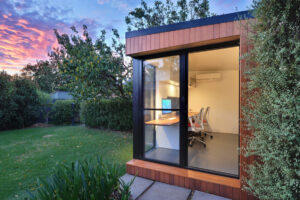
Small scale backyard offices have the benefit of easy access to nature when good design decisions are made.
Biophilia is the innate human attraction to nature and natural processes. It is a concept that has been gaining popularity in recent years, especially in the field of workplace design. Biophilic design is the practice of incorporating elements of nature into the built environment, such as plants, natural light, water features, natural materials, and views of nature.
Why is biophilia important for workplaces? Research has shown that biophilic design can have positive effects on the well-being, productivity, creativity, and satisfaction of workers. Some of the benefits of biophilia in workplaces include:
– Reduced stress and anxiety: Exposure to nature can lower blood pressure, heart rate, and cortisol levels, which are associated with stress and anxiety. Nature can also enhance mood and emotional regulation, helping workers cope with challenges and frustrations.
– Improved cognitive performance: Nature can stimulate the brain and improve attention, memory, problem-solving, and decision-making skills. Nature can also foster a sense of curiosity and exploration, which can spark innovation and creativity.
– Enhanced social interaction: Nature can facilitate communication, collaboration, and trust among workers. Nature can also create a sense of belonging and identity, which can increase engagement and loyalty.
– Increased physical health: Nature can promote physical activity, such as walking, cycling, or gardening, which can improve cardiovascular health, immune system function, and metabolism. Nature can also improve air quality, reduce noise pollution, and regulate temperature and humidity, which can prevent respiratory infections, headaches, fatigue, and discomfort.

A large green wall installation might help build better relationships in your office.
How to implement biophilia in workplaces? There are many ways to introduce biophilic elements into the workplace, depending on the budget, space, and preferences of the organization. Some examples of biophilic design strategies are:
– Introduce plants: Plants can add color, texture, and fragrance to the workplace. They can also purify the air, reduce noise, and provide a sense of privacy. Plants can be placed in pots, hanging baskets, vertical gardens, or green roofs.
– Maximize natural light: Natural light can enhance the circadian rhythm, which regulates the sleep-wake cycle and hormone levels. Natural light can also improve mood, alertness, and visual acuity. Natural light can be increased by using large windows, skylights, light shelves, or mirrors.
– Incorporate water features: Water features can create a soothing sound, a cooling effect, and a visual interest. They can also humidify the air and reflect light. Water features can be installed as fountains, ponds, aquariums, or water walls.
– Use natural materials: Natural materials can create a warm, cozy, and authentic atmosphere. They can also stimulate the senses of touch, smell, and sight. Natural materials can be used for flooring, furniture, walls, or accessories. Examples of natural materials are wood, stone, metal, leather, wool, or cotton.
– Provide views of nature: Views of nature can offer a sense of connection, diversity, and beauty. They can also inspire awe and wonder. Views of nature can be provided by using windows, balconies, terraces, or courtyards.
Biophilia is not only a trend but a necessity for workplaces in the modern world. By incorporating elements of nature into the workplace design, workers can enjoy a healthier, happier, and more productive work environment.
image references:
These Prefabricated Backyard Offices Are Incredible – Airows
How to Incorporate Biophilic Design in Any Space – gb&d (gbdmagazine.com)

A large green wall installation might help build better relationships in your office